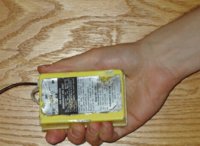This article originally printed in SARSCENE.http://www.nss.gc.ca/site/ss/magazine/vol14_3/beacons_e.asp BEACONSDiscarded ELT triggers search - a first-hand accountby Jack Onisimchuk On April 20, 2004 Industry Canada was called to track down and deactivate an emergency locator transmitter (ELT). At 15:45, the Edmonton District Office of Industry Canada was contacted by the Joint Rescue Co-ordination Centre (JRCC), Trenton. The COSPAS-SARSAT satellite the JRCC monitors had detected a signal on the international emergency frequency of 121.5 MHz, and they were giving us the heads-up that our help might be required. The JRCC quickly deployed a Hercules aircraft to sweep the area in an attempt to locate the source from the air. Nothing unusual was spotted, and it was decided that a ground search should be initiated. At 16:10 Industry Canada's assistance was formally requested. The responsibility to find and silence the beacon had now been handed to our department. While not a routine occurrence, many of our Spectrum Management Officers have been called upon in the past by the JRCC for similar duties. Our staff is trained, equipped and experienced in tracking down radio signals. Since the air search had not spotted a likely source (such as a downed aircraft) we felt we were dealing with an ELT that had been inadvertently activated. And while relieved to know that it was unlikely the result of a plane crash, we still had to act swiftly to find and deactivate the source. The possibility existed that the false alert could interfere with a genuine distress signal should an actual emergency occur in the same area. With the approximate location of the beacon loaded into our vehicular mapping/GPS system, and with the aid of our direction-finding equipment, we began our ground search. Within a half kilometre of the geographical coordinates JRCC supplied to us, our direction finder locked onto a signal and began providing bearings towards its origin. By 17:30 we had arrived at the entrance to the property where we believed the signal originated.
In the past we have found ELTs in diverse locations from aircraft and aircraft hangars, to maintenance shops and private homes. However we now found ourselves at the entrance to a large landfill site. Presented with acres of refuse, we realized this investigation had the potential to become an extremely difficult and time consuming process. With limited vehicular access, our Officer was soon on foot - switching to a handheld device for its portability. That allowed her to narrow down the signal to a large pile of garbage that had been hauled in that day. What followed could best be described as a team effort between our department, and the on-site workers. While we analysed our equipment readings and relayed the results to the workers, they began to sort through the rubble with their back-hoe. By carefully moving aside the debris one bucket at a time, we were finally able to zero in on the culprit. It was a small discarded ELT that could easily fit in the palm of the hand. Once located, the unit was opened, the batteries disconnected, and the transmitter silenced. It was now 19:05, less than 3 hours since our vehicle began its patrol.
While this exercise does highlight the effectiveness of the emergency beacon locator network that is currently in place, its use comes at a significant cost. Almost nine out of every 10 ELT distress signals prove to be falsely triggered and this has created a tremendous burden on the resources of all agencies involved. Yet with some due diligence on behalf of the users, most if not all of these false alarms could be eliminated. Some common causes of inadvertent ELT operation are improper storage or disposal where, as occurred in this instance, the unit was not properly deactivated. On board aircraft we have seen units that have been tripped by a hard landing or even severe air turbulence. As well, inadequate equipment maintenance procedures could contribute to false activation. When in doubt regarding the use, storage, maintenance or disposal of ELTs, the manufacturer's recommendations should be followed. It is our hope that the information presented in this article will help reduce the waste and potential safety issues that are associated with false distress signals. Jack Onisimchuk is a Spectrum Management Officer with the Spectrum Management, Information Technologies and Telecommunications sector of Industry Canada, located in the Prairies and Northern Region - based out of Edmonton. |
 The unit,
other than having a broken switch, was fully functional. As ELTs, by
design, activate when jarred we speculated it may have been triggered by
the heavy equipment used at the landfill site. However, the only thing
we can be certain of is that it had not been properly disposed of. The
ELT had been discarded still connected to its antenna and a live battery
pack, and obviously quite capable of triggering a satellite-borne
receiver while buried in trash.
The unit,
other than having a broken switch, was fully functional. As ELTs, by
design, activate when jarred we speculated it may have been triggered by
the heavy equipment used at the landfill site. However, the only thing
we can be certain of is that it had not been properly disposed of. The
ELT had been discarded still connected to its antenna and a live battery
pack, and obviously quite capable of triggering a satellite-borne
receiver while buried in trash.